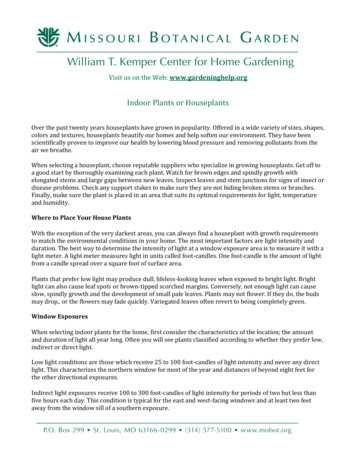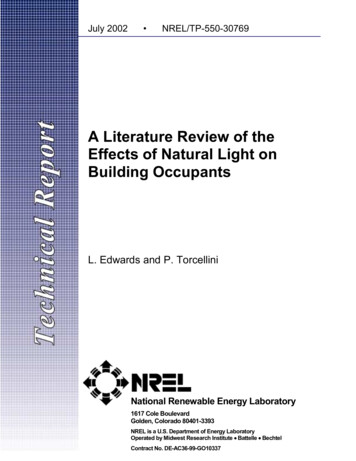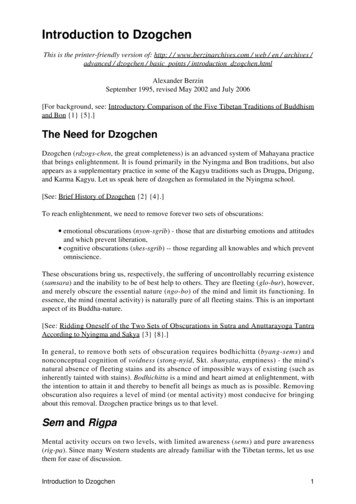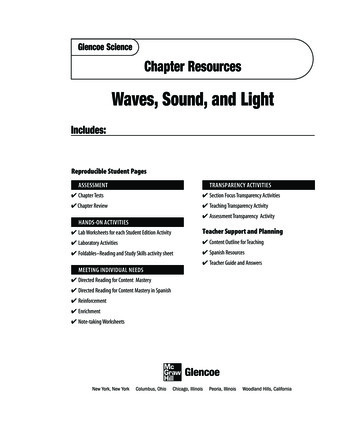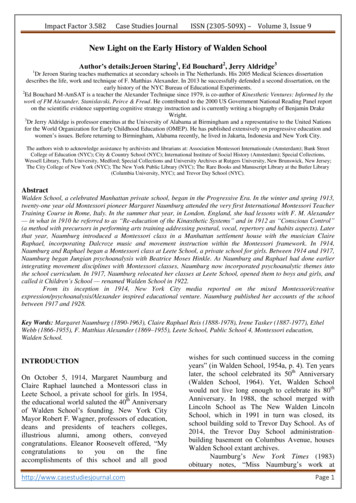
Transcription
Impact Factor 3.582Case Studies JournalISSN (2305-509X) – Volume 3, Issue 9New Light on the Early History of Walden SchoolAuthor’s details:Jeroen Staring1, Ed Bouchard2, Jerry Aldridge31Dr Jeroen Staring teaches mathematics at secondary schools in The Netherlands. His 2005 Medical Sciences dissertationdescribes the life, work and technique of F. Matthias Alexander. In 2013 he successfully defended a second dissertation, on theearly history of the NYC Bureau of Educational Experiments.2Ed Bouchard M-AmSAT is a teacher the Alexander Technique since 1979, is co-author of Kinesthetic Ventures: Informed by thework of FM Alexander, Stanislavski, Peirce & Freud. He contributed to the 2000 US Government National Reading Panel reporton the scientific evidence supporting cognitive strategy instruction and is currently writing a biography of Benjamin DrakeWright.3Dr Jerry Aldridge is professor emeritus at the University of Alabama at Birmingham and a representative to the United Nationsfor the World Organization for Early Childhood Education (OMEP). He has published extensively on progressive education andwomen‘s issues. Before returning to Birmingham, Alabama recently, he lived in Jakarta, Indonesia and New York City.The authors wish to acknowledge assistance by archivists and librarians at: Association Montessori Internationale (Amsterdam); Bank StreetCollege of Education (NYC); City & Country School (NYC); International Institute of Social History (Amsterdam); Special Collections,Wessell Library, Tufts University, Medford; Special Collections and University Archives at Rutgers University, New Brunswick, New Jersey;The City College of New York (NYC); The New York Public Library (NYC); The Rare Books and Manuscript Library at the Butler Library(Columbia University, NYC); and Trevor Day School (NYC).AbstractWalden School, a celebrated Manhattan private school, began in the Progressive Era. In the winter and spring 1913,twenty-one year old Montessori pioneer Margaret Naumburg attended the very first International Montessori TeacherTraining Course in Rome, Italy. In the summer that year, in London, England, she had lessons with F. M. Alexander— in what in 1910 he referred to as ―Re-education of the Kinæsthetic Systems‖ and in 1912 as ―Conscious Control‖(a method with precursors in performing arts training addressing postural, vocal, repertory and habits aspects). Laterthat year, Naumburg introduced a Montessori class in a Manhattan settlement house with the musician ClaireRaphael, incorporating Dalcroze music and movement instruction within the Montessori framework. In 1914,Naumburg and Raphael began a Montessori class at Leete School, a private school for girls. Between 1914 and 1917,Naumburg began Jungian psychoanalysis with Beatrice Moses Hinkle. As Naumburg and Raphael had done earlierintegrating movement disciplines with Montessori classes, Naumburg now incorporated psychoanalytic themes intothe school curriculum. In 1917, Naumburg relocated her classes at Leete School, opened them to boys and girls, andcalled it Children’s School — renamed Walden School in 1922.From its inception in 1914, New York City media reported on the mixed nder inspired educational venture. Naumburg published her accounts of the schoolbetween 1917 and 1928.Key Words: Margaret Naumburg (1890-1963), Claire Raphael Reis (1888-1978), Irene Tasker (1887-1977), EthelWebb (1866-1955), F. Matthias Alexander (1869–1955), Leete School, Public School 4, Montessori education,Walden School.INTRODUCTIONOn October 5, 1914, Margaret Naumburg andClaire Raphael launched a Montessori class inLeete School, a private school for girls. In 1954,the educational world saluted the 40th Anniversaryof Walden School‘s founding. New York CityMayor Robert F. Wagner, professors of education,deans and presidents of teachers colleges,illustrious alumni, among others, conveyedcongratulations. Eleanor Roosevelt offered, ―Mycongratulationstoyouonthefineaccomplishments of this school and all goodhttp://www.casestudiesjournal.comwishes for such continued success in the comingyears‖ (in Walden School, 1954a, p. 4). Ten yearslater, the school celebrated its 50th Anniversary(Walden School, 1964). Yet, Walden Schoolwould not live long enough to celebrate its 80thAnniversary. In 1988, the school merged withLincoln School as The New Walden LincolnSchool, which in 1991 in turn was closed, itsschool building sold to Trevor Day School. As of2014, the Trevor Day School administrationbuilding basement on Columbus Avenue, housesWalden School extant archives.Naumburg‘s New York Times (1983)obituary notes, ―Miss Naumburg‘s work atPage 1
Impact Factor 3.582Case Studies JournalWalden School influenced the nation‘seducational philosophy. She was among thepioneers in breaking away from a formal bookcentered curriculum.‖ Her Boston Globe (1983)obituary begins, ―Though Margaret Naumburg‘sfirst book, ‗The Child and the World,‘ written in1928, laid out her own educational philosophy, thedirection for her pioneering work with childrenmay have been set between 1912 and 1914, whenshe studied under Maria Montessori in Rome andF. Matthias Alexander in London.‖In this article, the authors explore the earlyhistory of Walden School, focusing onNaumburg‘s explorations of various approaches tomovement education and psychoanalysis justbefore her older sister and art therapy pioneerFlorence Cane joined the faculty in 1923.Three aspiring Montessori teachersMargaret Naumburg (1890-1963) was the third ofthree daughters of Theresa (née Kahnweiler)Naumburg and textile manufacturer MaxNaumburg. Her siblings were her older sistersAlice and Florence, and younger brother Robert.In 1908, at age eighteen, she began attenting atVassar College Vassar College (Poughkeepsie,New York). In March 1911, the New York Times(1911) reported a costume ball in her honour (with150 guests). In June 1912, she completed her B.A.not at Vassar but at Barnard College in New YorkCity, another elite Seven Sisters school. AtBarnard, she was president of The Socialist Club,rooming with Evelyn Dewey, daughter of JohnDewey. After graduation, she travelled to Europe.Naumburg biographer Hinitz (2002, 2013)asserts that she studied economic reform at theLondon School of Economics; however, itremains unclear whether, with whom, and, if so,how long she studied economics in England. Onship‘s passage to Europe she first readMontessori‘s 1912 The Montessori Method; then,―From London in September she went to Rome;went to work in Montessori‘s laboratory‖(Rosenfeld, 1924. p. 117). On September 25,1912, she met with Maria Montessori. In ahandwritten letter addressed to Dr. Montessori,written on Grand Hotel Michel at Via Torinostationary, Naumburg thanked Montessori formeeting with her, emphasizing that she wouldlove further study in her method:Dear Dr. Montessori,http://www.casestudiesjournal.comISSN (2305-509X) – Volume 3, Issue 9I meant to tell you that a week or soago I wrote to my twin nieces for theirsecond birthday, and as the best wish Iknew, I hoped they would be broughtup the Montessori way. Even then Iscarcely realized what a splendid wishit was, for I had not talked with you orseen the children!You told me many of the excitablechildren slept more calmly after a fewweeks at the school. Am I too big tosay that I slept better last night forhaving been with you yesterday? Ifyour book made me wish that I couldstudy with you, you yourself have sostrengthened that desire, that it will notbe my fault if I do not come back toyou soon.Would you and the children take theseflowers with all my love? (Naumburg,1912)Within four months, she was number 51 of eightystudents accepted in the First InternationalMontessori Teacher Training Course, given byMontessori between January 15 and May 15,1913. During her stay in Rome, Naumburgbefriended Irene Tasker and Ethel Webb — twoBritish women who also attended Montessori‘scourse. Later, Tasker would describe the meetingto a colleague: ―I went out to Rome in 1912 tostudy with Dr Montessori. And in early 1913 wasjoined by Ethel Webb who had already startedworking with F.M. [Alexander] I thought therewas an educational connection to be madebetween his work and that of Montessori. In Romewe both made the acquaintance of MissNaumburg, an American, who was studying withMontessori and was herself a pupil of Dewey‘sand friend of his family‖ (Tasker, 1957).Ethel Webb (1866-1955) was a daughter ofAnn Theresa (née Bennett) Webb and GeorgeWebb. With John Mappin, her father founded thelegendary Mappin and Webb London silversmithchain. A budding concert pianist, her career wascut short by apparent piano-playing related backand arm injuries. For a time, she taught privatepiano lessons in Manhattan, but discontinued herteaching practice when her family disapproved:‗A woman from her social rank should not takestudents for pay.‘ Webb may have begun lessonswith Alexander to address problems related to herPage 2
Impact Factor 3.582Case Studies Journalpiano-related injuries as early as 1910 (possiblyafter having read his 1910 book Man’s SupremeInheritance). Soon Webb became one ofAlexander‘s most trusted permanent advocates. In1911, she became an assistant to Alexander. Oneof her main duties was helping him edit his textslike a 1912 book titled Conscious Control(Staring, 2005). Although Alexander spoke,dressed, and had a manner giving a firstimpression he was educated English gentleman,he in fact had no formal schooling after agethirteen. He had employed a ghost writer,uncredited, to assist with his first book (ibid.).Now Webb seems to have taken on similar behindthe scene duties. Early in 1913, she travelled toRome to attend Montessori‘s first internationaltraining course for teachers.Irene Tasker (1887-1977) was a daughterof Ellen Martha (née Sanderson) Tasker and Rev.John Greenwood Tasker, principal of HandsworthCollege, a Wesleyan seminary in Birmingham,England. In 1910, she completed the ClassicalTripos at Girton College Cambridge. Between1910 and 1912, she taught a group of children inCambridge (Butler & McMorran, 1949).Functioning essentially as an English governess,her employer gave her a copy of William JamesTalks To Teachers to guide how she would teachthe children (Tasker, 1978, p. 9). Mid-1912, shetravelled to Rome as English representative of theMontessori Society of the United Kingdom toassist Maria Montessori with her experiments ofteaching older children. ―She has been sent out tolearn the whole method herself, in such a way asto teach it to teachers on her return‖ (Walker,1913, p. 306; see also Tasker, 1915). WhenMontessori organized the first international coursefor teachers, Tasker enrolled immediately.After receiving their Montessori teachercertificates in May 1913, Naumburg, Tasker andWebb travelled to London where Webbintroduced Naumburg and Tasker to F. M.Alexander — now her employer. It is not clearthat she was a paid employee, however. Webbconvinced her new Montessori colleagues thatthere are supportive parallels between Alexander‘smethod of ―re-education‖ and Montessori‘smethod. With her new friends, Webb shared acopy of Alexander‘s (1912) Conscious Control —to which Webb may have made contributions.One passage refers to how ―the means rather thanthe end must be held in mind‖ (p. 3). There ishttp://www.casestudiesjournal.comISSN (2305-509X) – Volume 3, Issue 9perhaps a parallel in Montessori, in which, inTasker‘s 1978 words, Montessori designs―children‘s occupations in such a way that nopiece of work done was an end in itself, but ameans to another end‖ (p. 9). Both womenexperienced lessons with Alexander, both formingfavorable impressions. Naumburg encouragedAlexander to teach in Manhattan (ibid.). As well,subsequently, Tasker would join Webb as anassistant to Alexander.After the visit, Webb resumed her work atAlexander‘s London headquarters; and Taskerbegan translating Dr. Montessori’s OwnHandbook, published in 1914. That year Taskeralso took a post as lecturer on Montessorieducation at Darlington Training College inDarlington, Yorkshire, and, in June 1914, beganteaching a Montessori class in the DarlingtonBeaumont Street Infant School (Stanton, 1966). InNovember that year, however, the UnitedKingdom War Office requisitioned the school ―forbilleting purposes‖ — converting Tasker‘sclassroom ―into a soldiers‘ guard-room‖ (Tasker,1915, p. 8). Subsequently, the school combinedwith a Darlington Council School, sharingclassrooms half time, which Tasker soon founduntenable.1913: Henry Street Settlement MontessoriClassMid-1913, Naumburg travelled on to New YorkCity. Together with co-teacher Claire Raphael shebegan offering a Montessori class at LillianWald‘s Henry Street Settlement in Manhattan‘sLower East Side (Evening Post, 1916a). ClaireRaphael (1888-1978) was a daughter of Eugenie(née Salomon) Raphael and Gabriel M. Raphael.Raphael had studied dance and music in France,Germany, and then at New York Institute ofMusical Art (later renamed The Julliard School).Naumburg and Raphael first met in London in thesummer of 1913, when Raphael attended T. H.Yorke Trotter‘s Rhythmic Method of TeachingMusic classes at the London Conservatory ofMusic (Thomas, 1991). Raphael‘s enthusiasm fordance motivated Naumburg to study ÉmileJacques-Dalcroze‘s Eurhythmics (Naumburg,1914), and attend Interpretative Dancing courseswith children‘s dance educator Alys E. Bentley. Inturn, Naumburg influenced Bentley and herstudents by introducing Bentley to Alexander‘sPage 3
Impact Factor 3.582Case Studies Journalunique, indirect approach to addressing postureand breathing habits (D‘Houbler, 1921, 1925;Ross, 2000). As well, between 1914 and 1916,Naumburg did postgraduate work under JohnDewey at Teachers College.Later that year, Maria Montessori touredNew York City schools. In an article in the 13December Outlook, Naumburg does not addressthe pedagogy Montessori developed at Casa deiBambini in Rome. Rather, she stresses thatMontessori was the first Italian woman to receivea doctor‘s degree, extolling her as a feminist whoknows no fear and fights for ―social freedom,‖who works with children ―as the unpollutedsource from which the democracy of the futuremust rise‖ (p. 797). Highest credit was forBarones Franchetti to whom Montessori haddedicated The Montessori Method, and ItalianQueen Mother Marguerites who financiallyassisted the work.Naumburg, unwisely, stepped in aninternational school war, professing thatMontessori had ―felt the unofficial censure of theCatholic Church,‖ and had been opposed ―by theforce of Jesuit priests‖ who had ―been successfulin preventing the foundation of a Montessorischool in Ireland‖ (p. 798). Her protestations wereimmediately ridiculed by an American-Irish Jesuitas ―rank bosh‖ (O‘Connor, 1913, p. 71).Naumburg (1913) stated that the firstinternational training class for teachers gaveMontessori ―a fresh surge of Wanderlust‖ (p.798), which led to her departure from Rome forAmerica. She highlights Montessori‘s ―radiantpresence‖ when addressing an audience; then,gushing, in conclusion, with found reminiscencesof their first meeting in September 1912: ―Iremember vividly the dull wait in her drawingroom. I dreaded the meeting, lest the womanshould be less than her book. Then the dooropened, and Montessori came towards me.Serenity breathed from her as she entered theroom‖ (p. 799). The Madonna-like photograph ofMontessori Outlook editors published with thearticle lent credence to Naumburg‘s floridportrayal.Naumburg knew her audience of readers.The Outlook article sparked considerable interestin the Henry Street Settlement Montessori classamong educators. Soon visitors includedFanniebelle Curtis, Director of New York CityKindergartens and Elizabeth Farrell, Director ofhttp://www.casestudiesjournal.comISSN (2305-509X) – Volume 3, Issue 9Ungraded Classes (Thomas, 1991). Emma L.Johnson, Director of the Brooklyn TrainingSchool for Teachers, attended Montessori‘sDecember 11 address at the Academy of Music(Daily Standard Union, 1913). Johnson invitedNaumburg to lecture on Montessori at BrooklynTraining School on December 22, to demonstrate―the complete series of [Montessori] didacticmaterials, showing how each article is used in thetraining of children‖ (Brooklyn Daily Eagle,1913). This was just days before Montessori leftthe United States for Rome.1914: Montessori education at Leete SchoolAs with Tasker‘s Montessori classes at theDarlington school, the war disrupted Alexander‘sLondon teaching practice. Born in 1869,approaching fifty, too old for the war effort, F. M.Alexander now accepted Naumburg‘s invitation toexplore teaching opportunities in the UnitedStates. He boarded the Lusitania on September 12,1914, arriving in New York Harbor five dayslater. Naumburg helped him find suitable roomsfor a teaching practice in the Essex Hotel.There is no evidence that Alexander evenonce mentioned in New York his recentpartnership with Mr. Ambrose Adrian Allen ofHarrow. In February 1914, official records showthey formed Ovoleo Drug Company Ltd. Recentresearch reveals that not only did Alexanderregister the company in London, he obtainedpatents in both Canada and the United States. TheOvoleo Drug Company business plan wasapparently to market products with a special―tasteless‖ recipe of cod liver oil and eggs(London Standard, 1913). His failure to followthrough suggests that Alexander may have merelylent his name to provide legitimacy to investorsfor an enterprise promoted by his younger sisterand youngest brother Beaumont, who is listed as acompany director in the documents. The drugcompany archives do reveal an ever-presententrepreneurial side of Alexander. As the oldestchild of seven surviving siblings, he had becomethe main support of the family. Alexander wasborn into far less substantial means than those ofhis far better educated assistants. F. MatthiasAlexander (1869–1955) was the eldest son ofBetsy (née Brown) and John Alexander of theremote, down under village of Table Cape,Tasmania. By about 1900, his parents hadpermanently separated. Hence forward, AlexanderPage 4
Impact Factor 3.582Case Studies Journaldeclared that his father had died, although hecontinued to live until the 1930s. His mother hadonce been a mid-wife. His father was an illiterate,apparently physically abusive blacksmith, mainlyknown for his love of betting on horses andalcohol consumption. After a brief apprenticeshipwith an elocution teacher in Melbourne, about1892, for the remainder of his days, the talentedMr. Alexander, in fact the eldest son of Betsy andJohn Alexander, instead gave impression that hewas ‗to the manor born‘ (see: Staring, 2005).In May 1915, Alexander returned toEngland. Between 1914 and 1924 (with theexception of winter 1922), Alexander spentsummers in London and winters in New York.Alexander Technique literature claims thatNaumburg brought him many influential (andsometimes fabulously wealthy) clients during his1914-1915 New York sojourn. No supportingevidence exists. It is, however, highly likely thatNaumburg introduced Alexander to men‘sclothing manufacturer Arthur M. Reis (18831947) and to novelist and journalist Waldo Frank(1889-1967). Claire Raphael married Reis inDecember 1915. Naumburg married Frank a yearlater.Alexander did begin teaching ten-year-olddaughter of Andrew Carnegie‘s partner SylvanusLathrop Schoonmaker. By end of 1914, EthelWebb arrived from London to assist and becomethe girl‘s resident teacher. When Alexanderreturned to London in spring 1915, Webb stayedbehind.EvidencesuggeststhatWebbsubsequently won over several of her old NewYork friends, among whom were Mary PotterBush and her husband millionaire and ColumbiaUniversity scholar Wendell T. Bush, who beganlessons with Alexander as soon as the latterreturned to the United States (Staring, 2005).Sometime in 1914, around Alexander‘sarrival, Naumburg and Raphael discontinued theirHenry Street Settlement class. In its stead, onMonday, October 5, 1914, they opened aMontessori class at Leete School. Leete is aprivate school for girls at 17 E. 60th Street, nearMidtown Manhattan, never known as a poorimmigrant neighbourhood. The Montessori classmet just half-days. Hours of attendance were from9:30 to 12 (Evening Post, 1914; Sun, 1914). Theprivate Montessori experiment at Leete Schoolbegan with only three children. Soon thisMontessori class received inquiring visitors too.http://www.casestudiesjournal.comISSN (2305-509X) – Volume 3, Issue 9Interestingly, Naumburg and Raphael hadattended Marietta Johnson‘s 1914 FairhopeSummer School in Greenwich, Connecticut.Johnson, in turn, gave a talk at Leete School inFebruary 1915 (Evening Post, 1915b; Staring,2013b). In March 1915, Naumburg and Raphaelwelcomed teachers from the Brooklyn TrainingSchool for Teachers — where Naumburg inDecember 1913 had previously lectured onMontessori (Evening Post, 1915a).1915: Public Montessori education at PS4Sometime during the school year, SimonHirsdansky, Principal of Public School 4 (PS 4) inThe Bronx and Fanniebelle Curtis, Director ofNew York City Kindergartens, invited Naumburgand Raphael to apply to teach a Montessori classin Hirsdansky‘s public school. Naumburg‘ssolicitation before the Board of EducationCommissioner George J. Gillespie appeared to besuccessful. Perhaps there was also support fromNew York City‘s recently elected new progressivemayor, John Puroy Mitchel, They received theBoard‘s approval shortly after, on April 13, 1915.The experimental class began April 19. Naumburgand Raphael would not only utilize a classroom inPS 4 for their public education Montessoriexperiment — but, they learned, there was, aswell, a porch of Bronx House Settlementassociated with PS 4 for outdoor play and work.Only a day later, on April 20, MariaMontessori, on her second United States tour,spoke at an American Montessori teachers‘conference at the Children‘s House, a Montessorischool in a model tenement at 520 E. 77th Street,Naumburg announced the good news. ―We havejust secured permission to establish a class inPublic School 4. It was only possible because ofthe enthusiasm of the principal for [your] work.‖However, perhaps Naumburg saw a cloud on thehorizon; she pleaded, ―But you Dottoressa whywon‘t you stay and help us?‖ Montessori hadfamously insisted that it was ―easier to teach thechildren of the poor‖ than children of means.Naumburg‘s experience differed. She stated, ―Ihad a group of poor children last winter, and agroup of well-to-do children this winter and thelatter learned in six weeks more than the formerlearned in a year‖ (in Rodman, 1915a).From its small beginnings, the Montessoriclass at Leete School began to flourish. Early May1915, feminist educator Henrietta RodmanPage 5
Impact Factor 3.582Case Studies Journal(1915b) reported on the Montessori class at LeeteSchool for New York Tribune. Rodman found thatthe class was not strictly Montessori. Instead,Raphael and Naumburg were merging Montessori,Froebel, Bentley Interpretative Dancing, DalcrozeEurhythmics, and Alexander‘s method of motorhabit re-education. Rodman quoted Raphaelasserting, ―I was amazed at first to find that Dr.Montessori did so little work with sound in hersense training. Then I realized that no onegenius can possibly construct a complete systemof education.‖ Naumburg acknowledged, ―Wehave accepted Dr Montessori‘s work with keenappreciation of its great value and we haveadded to it what we have learned from other greatteachers, from Froebel and Dalcroze, and MissBentley, and most recently from Mr. MatthiasAlexander, of London.‖Just one month later, in May 1915,ostensibly since PS 4 had become extremelyovercrowded, the public school administrationtransferred the Montessori class to the enclosedporch of Trinity Annex, a church school buildingand annex of PS 4 at Washington Avenue and176th Street (Sun, 1916). Was the move andovercrowding unexpected by school boardadministrators? Did Naumburg and Raphaelrealize the threat this move to the annex posed totheir public school Montessori experiment? Theydid begin to take up the cause to prevent publicschool overcrowding. The June 23, 1915, Outlook,had Naumburg‘s (1915) first article on the GarySystem — a plan to address overcrowding byclass reorganization implemented by William Wirtof Gary, Indiana, which school reformersproposed implementing in New York City publicschools. As well, the October 22, 1917, EveningPost (1917) quoted Raphael — now Mrs. ArthurM. Reis, and Vice-Chair of the Gary SchoolLeague as well as Chair of the EducationCommittee of the Women‘s City Club —advising, ―Parents should learn about the Garysystem by watching it in operation at the [NewYork City] schools.‖1916: Public education tragedy vs. privateeducation successIn the autumn of 1915, Alexander returned to NewYork City welcomed by Ethel Webb. Heimmediately began teaching the Bushs, and, ontheir, Webb and likely Naumburg‘s references,Alice Chipman Dewey (John Dewey‘s wife) andhttp://www.casestudiesjournal.comISSN (2305-509X) – Volume 3, Issue 9several of their children. Early in 1916, he metJohn Dewey, who also took lessons. Other leadingNew York City academics did too, includingRichard M. Hodge (Teachers College and UnionTheological Seminary faculty), Horace Kallen(future New School philosophy of aestheticsfaculty), Wesley Mitchell (Columbia and futureNew School economics faculty), and James H.Robinson (Columbia history faculty and futureNew School faculty). As well, perhaps the mostinfluential (but least recognized until recently)was progressive education curriculum designerand education reform activist Lucy SpragueMitchell. Wesley was Sprague Mitchell‘shusband. They also brought their children toAlexander for lessons.NaumburgandRaphael‘sprivateMontessori classes thrived. When Leete Schoolopened for the autumn 1915 term, enrollmentsurged. Parents who could afford tuition anywherefound Naumburg and Raphael‘s approach ofintegrating Montessori with music and dancetraining desirable for their children. They now hadtwo groups of children in Montessori classes atLeete.The 1915-1916 school year Montessoriexperimental class in the public school did notfare as well. During the winter of 1916,Naumburg and Raphael‘s PS 4 class abruptly loststudents. Cold weather had forced a second move,from the enclosed Trinity Annex porch to theAnnex‘s ―dark and badly ventilated cellargymnasium‖ (New York Tribune, 1916).Astoundingly, the Board of Education hadprovided no funding to heat the classroom, not tomention minimal furnishing of equipment andsupplies (A Statesman‘s Granddaughter, 1916;Evening World, 1916; Feigenbaum, 1916; NewYork Call, 1916; New York Tribune, 1916; Sun,1916). Eventually, the PS 4 Montessori classcompletely dissolved. Naumburg resigned inFebruary 1916.The sorry episode raises several questions:When Naumburg wrote her article criticizing IrishCatholic and Jesuit reception to Montessori (seeabove), did she inadvertently, perhaps naively,and certainly unnecessarily make enemies withinsectors of the New York City public schoolsystem? Especially among Catholic sectors? Didreligious and ethnic biases play a role? DidHorace Kallen‘s theory of ―cultural pluralism‖enter into the discussion of the education reformPage 6
Impact Factor 3.582Case Studies Journalactivists? Those questions are beyond the scope ofthis article. Except, the story of early twentiethcentury New York City school wars has beenrepeatedly visited by able historians, especially,Cohen (1963), Ravitch (1974/1988), and recentlyStaring (2013b). The consensus is that theseschool wars, which certainly concerned importantdebate about how to deliver education, the kind ofconcerns addressed by Naumburg and hercolleagues, also occurred within shifts of powerbetween old Protestant elite and newly emergingcivic power among Irish Catholics. The latterarrived during an early nineteenth centuryimmigration, when the population of ―[Irish]Catholic population of New York City rose from1,300 in 1800 to 100,000 in 1800‖ (Cohen, 1975).By 1890s, Protestant and Catholic power centerswere not only vying for control of civicgovernmental, both faced new threats from asecond, much larger influx of immigrants.The statistics are staggering. From about1890 until looming of America‘s entrance intoWWI in 1915, some 13 million immigrants cameto make a new home in the United States (Ratner,1984). Most passed through Ellis Island, manysettled in New York City, seventy-five percent ofwhom were Jews from Russia and EasternEurope, perhaps another twenty-five percentCatholics from Italy. The city hardly had housingor other infrastructure to meet their needs.Novelists and essayist documented all the worstslum conditions. One Protestant response, drawingon a rich missionary tradition, was to turn schoolsinto welfare agencies and offer to education theimmigrant children (Cohen, 1964).The idea to ‗Americanize‘ the newresidents via schooling followed a long Englishtradition. The British strategy of using educationto sustain empire dates at least to latterElizabethan England and East India Companyformation in 1600. It was not limited to India.According to a 1628 Charter, convertingAmerican ―Indians‖ to Christianity was ostensiblythe principal aim of the Massachusetts BayColony (Frazier, 1975, p. 18). The British Empiretradition may have been best summed up in 1838by Thomas Babington Macaulay, 1st BaronMacaulay, who advocated English schooling inIndia ―to form a class who may be interpretersbetween us and the millions whom we govern, —a class of persons Indian in blood and colour, butEnglish in tastes, in opinions, in morals and inhttp://www.casestudiesjournal.comISSN (2305-509X) – Volume 3, Issue 9intellect.‖ (Parenthetically, a great nephew of 1stBaron Macaulay, Sir George Trevelyan, was astudent in F. M. Alexander‘s first training coursefor Alexander Technique teachers in the 1930s).In early twentieth century New York,empire instead translated
years‖ (in Walden School, 1954a, p. 4). Ten years later, the school celebrated its 50th Anniversary (Walden School, 1964). Yet, Walden School would not live long enough to celebrate its 80th Anniversary. In 1988, the school merged with Lincoln School as The New Walden Lincoln School, which in 1991 in turn was closed, its




